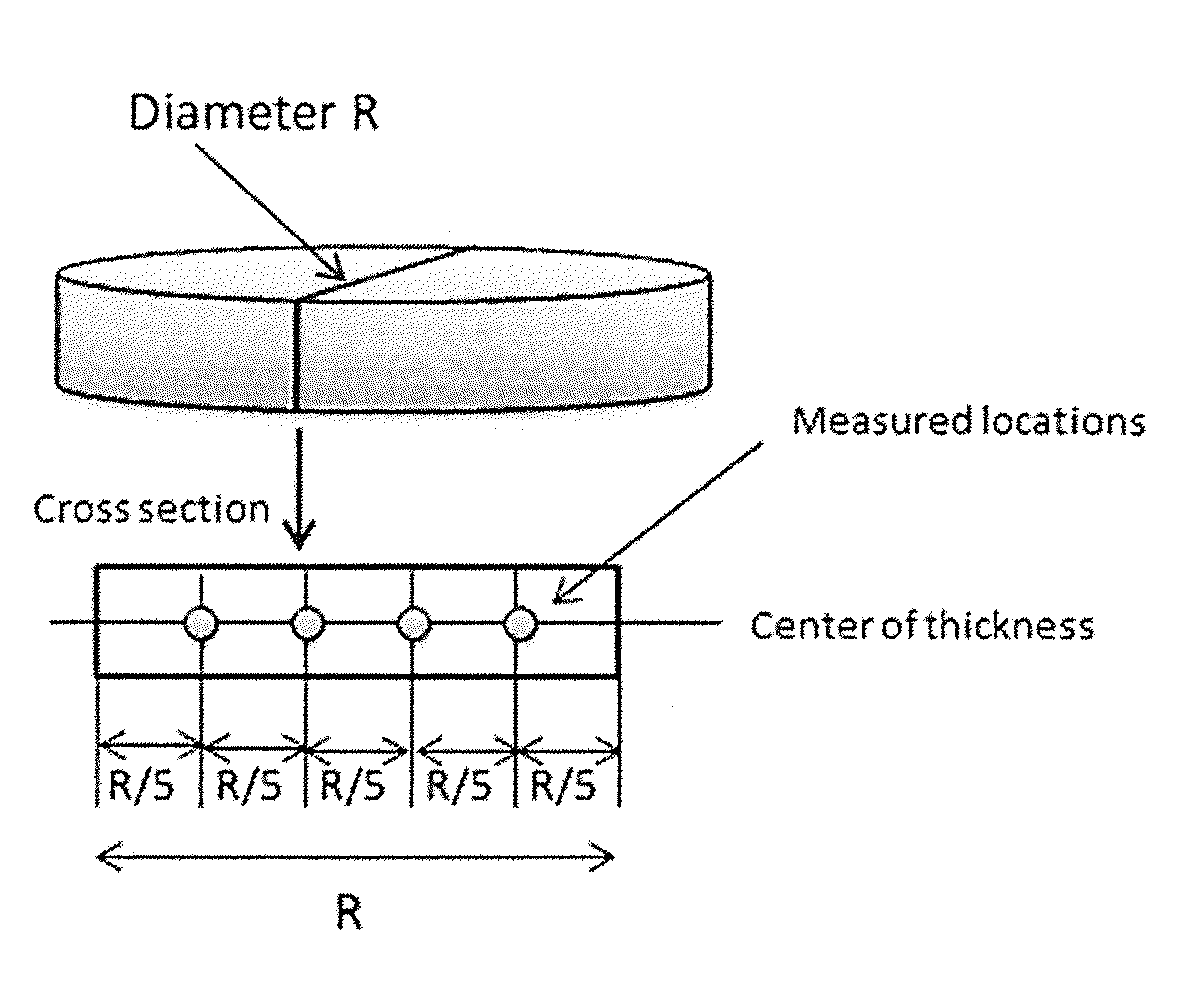SPUTTERING TARGET OF SINTERED Sb-Te-BASED ALLOY
a technology of sputtering target and te-based alloy, which is applied in the direction of vacuum evaporation coating, coating, electric discharge tube, etc., can solve the problems of deteriorating the quality or yield of thin film as recording medium, affecting the film quality of sputtered film, and non-uniform formation of thin film, so as to improve the characteristics of sb—te-based alloy, improve the quality of target, and stable sputtering
- Summary
- Abstract
- Description
- Claims
- Application Information
AI Technical Summary
Benefits of technology
Problems solved by technology
Method used
Image
Examples
example 1-1
[0047]As shown in Table 1, the respective raw material shots of Te, Sb, and Ge having a purity of 99.999% (5N) excluding gas components were weighed to attain Ge: 9.5 at %, Sb: 55.1 at %, and Te: 35.4 at %. The raw materials were selected to have a grain size of 5 mm or less with the intention of preventing oxidation. Next, these powders were subject to high frequency melting in a melting furnace, which was vacuumed to have a vacuum degree of 8.5×10−3 Pa or less, at 950° C. for 10 minutes. After the melting process, gas atomization was performed using high purity Ar gas with the target level being a grain size of 20 μm.
[0048]Jet mill pulverization was performed in order to refine and uniformly disperse the oxides in the powders. Consequently, a raw material powder having an average grain size of 2 μm, a maximum crystal grain size of 5 μm, and an oxygen content of 2000 wtppm was obtained. The obtained raw material powder was sintered via hot pressing (vacuum, rate of temperature incr...
example 1-2
[0050]A sintered target was prepared based on the same production conditions as Example 1-1 using the composition shown in Table 1. With the obtained target, the average oxygen concentration was 1600 ppm, the maximum value of the oxygen concentration was 2500 ppm, and the difference in the oxygen concentration was 1300 ppm. As the oxides, Sb2O3, GeO2 were recognized. Moreover, the average grain size of the oxides was 0.1 μm, the maximum grain size was 1.1 μm, and the number of grains having a size of 1 μm or more relative to the total number of grains was 0.2%.
[0051]As a result of sputtering the thus obtained target, the number of particles generated was 37 particles and fewer than the number of particles of Example 1, and favorable results were obtained. The foregoing results are shown in Table 1. Table 1 also shows the main oxides that existed in the target.
example 1-3
[0052]As shown in Table 1, other than adding In, a sintered target was prepared based on the same production conditions as Example 1-1. As a result of evaluating the thus obtained target, the average value of the oxygen concentration was 1800 ppm, the maximum concentration was 2000 ppm, and the difference in the oxygen concentration was 1500 ppm. As the oxides, GeO2, TeO2 were recognized. The average grain size of the oxides was 0.2 μm, the maximum grain size was 1.3 μm, and the number of grains having a size of 1 μm or more relative to the total number of grains was 0.1%.
[0053]Moreover, the number of particles generated during sputtering was 80 particles and fewer than the target level of 100 particles, and favorable results were obtained. The foregoing results are shown in Table 1. Table 1 also shows the main oxides that existed in the target.
PUM
| Property | Measurement | Unit |
|---|---|---|
| grain size | aaaaa | aaaaa |
| grain size | aaaaa | aaaaa |
| size | aaaaa | aaaaa |
Abstract
Description
Claims
Application Information
 Login to View More
Login to View More - R&D
- Intellectual Property
- Life Sciences
- Materials
- Tech Scout
- Unparalleled Data Quality
- Higher Quality Content
- 60% Fewer Hallucinations
Browse by: Latest US Patents, China's latest patents, Technical Efficacy Thesaurus, Application Domain, Technology Topic, Popular Technical Reports.
© 2025 PatSnap. All rights reserved.Legal|Privacy policy|Modern Slavery Act Transparency Statement|Sitemap|About US| Contact US: help@patsnap.com

